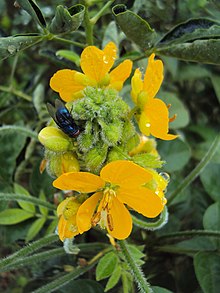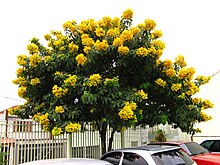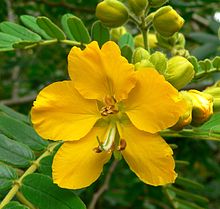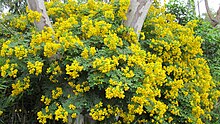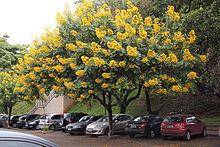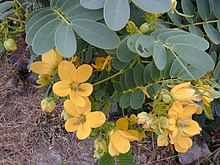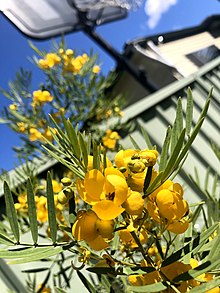
Cassia is a genus of flowering plants in the legume family, Fabaceae, and the subfamily Caesalpinioideae. Species are known commonly as cassias. The genus includes 37 species and has a pantropical distribution. Species of the genera Senna and Chamaecrista were previously included in Cassia. Cassia now generally includes the largest species of the legume subtribe Cassiinae, usually mid-sized to tall trees.

Senna spectabilis is a plant species of the legume family (Fabaceae) in the subfamily Caesalpinioideae native to South and Central America. They are often grown as an ornamental in front yards, parks, gardens, buildings etc. due to their bright yellow flowers that bloom during the summer months. They are also known as golden wonder tree, American cassia, popcorn tree, Cassia excelsa, golden shower tree or Archibald's cassia.

Senna alexandrina is an ornamental plant in the genus Senna. It is used in herbalism. It grows natively in upper Egypt, especially in the Nubian region, and near Khartoum (Sudan), where it is cultivated commercially. It is also grown elsewhere, notably in India and Somalia.

Chamaecrista is a genus of flowering plants in the pea family, Fabaceae, subfamily Caesalpinioideae. Members of the genus are commonly known as sensitive pea. Several species are capable of rapid plant movement. Unlike the related genera Cassia and Senna, members of Chamaecrista form root nodules.

Pithecellobium is a genus of flowering plants in the family Fabaceae. It includes approximately 23 species from the tropical Americas, ranging from Mexico to Peru and northern Brazil, including the Caribbean Islands and Florida.
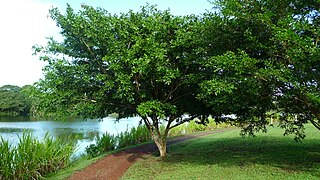
Zygia is a genus of flowering plants in the family Fabaceae. It includes 60 species of tres and shrubs native to the tropical Americas, from Southern Mexico and Cuba to northern Argentina. Typical habitats are tropical forest and coastal zones, generally below 900 meters elevation with a few species extending up to 2800 meters. It belongs to the mimosoid clade of the subfamily Caesalpinioideae.

Senna wislizeni, commonly called Wislizenus' senna or shrubby senna. Formerly in the "wastebin taxon" Cassia sensu lato, it is now placed in the genus Senna or sometimes separated in Palmerocassia together with Senna unijuga.

Cassia javanica, also known as Java cassia, pink shower, apple blossom tree and rainbow shower tree, is a species of tree in the family Fabaceae. Its origin is in Southeast Asia, but it has been extensively grown in tropical areas worldwide as a garden tree owing to its beautiful crimson and pink flower bunches.

Senna acclinis, commonly known as rainforest cassia or brush senna, is a species of flowering plant in the family Fabaceae and is endemic to near-coastal areas of eastern Australia. It is a shrub with pinnate leaves and bright golden yellow flowers in groups of two to five and long, narrow seed pods. It is similar to other species of Senna that are environmental weeds.

Senna pendula, also known as Easter Cassia, Christmas Senna, winter Senna, climbing Cassia, golden shower, pendant Senna and valamuerto, is a plant of the Fabaceae family with a shrub habit that is native to South America. It used in various parts of the world as an ornamental plant and is an environmental weed in Australia. The flowers are yellow and the name pendula means 'pendulous' or 'drooping'.
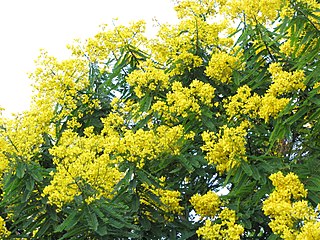
Senna multijuga, commonly known as November shower or false sicklepod, is a species of flowering plant in the family Fabaceae. It is native to wet tropical areas of Latin America, and widely introduced to other tropical locales such as Africa, India, Indonesia, China, Australia, and Hawaii. A fast-growing tree typically 10 m (33 ft) tall, it is planted in restoration projects, as an ornamental, and as a street tree, being especially useful under power lines.
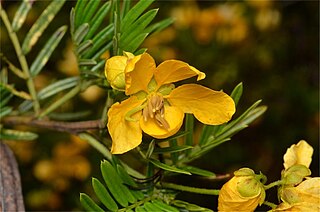
Senna aciphylla, commonly known as sprawling senna or Australian senna, is a species of flowering plant in the family Fabaceae and is endemic to eastern Australia. It is a sprawling shrub with pinnate leaves with eight to twelve pairs of linear to narrowly elliptic leaflets, and yellow flowers in pairs or groups of three.

Senna coronilloides, commonly known as brigalow senna, is a species of flowering plant in the family Fabaceae and is endemic to eastern Australia. It is an erect, sprawling shrub with pinnate leaves with nine to twelve pairs of elliptic leaflets, and groups of three to five yellow flowers in upper leaf axils.

Senna glutinosa is a species of flowering plant in the family Fabaceae and is endemic to central and northern arid areas of Australia. It is a shrub or small tree with pinnate leaves with up to seven pairs of leaflets, their shape depending on subspecies, and yellow flowers arranged in groups with ten fertile stamens in each flower.

Senna hirsuta, commonly known as woolly senna, is a species of flowering plant in the family Fabaceae and is native to Central and South America, but is naturalised in many other countries. It is an erect or spreading shrub or herbaceous perennial with pinnate leaves, with two to six pairs of egg-shaped leaflets, and yellow flowers arranged in groups of two to six, with six fertile stamens and four staminodes in each flower.
Senna leptoclada is a species of flowering plant in the family Fabaceae and is endemic to Arnhem Land in northern Australia. It is a glaucous, erect to drooping shrub with pinnate leaves usually with two pairs of broadly elliptic leaflets, and yellow flowers arranged in groups of two or three, with ten fertile stamens in each flower.

Senna oligoclada is a species of flowering plant in the family Fabaceae and is endemic to northern Australia. It is an erect shrub with pinnate leaves with one to three pairs of elliptic to egg-shaped leaflets, and yellow flowers arranged in groups of three to five with ten fertile stamens in each flower.





